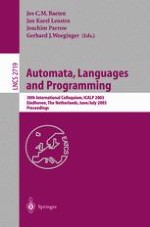2003 | Buch
Automata, Languages and Programming
30th International Colloquium, ICALP 2003 Eindhoven, The Netherlands, June 30 – July 4, 2003 Proceedings
herausgegeben von: Jos C. M. Baeten, Jan Karel Lenstra, Joachim Parrow, Gerhard J. Woeginger
Verlag: Springer Berlin Heidelberg
Buchreihe : Lecture Notes in Computer Science
Enthalten in: Professional Book Archive
